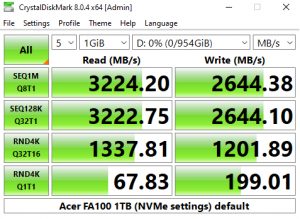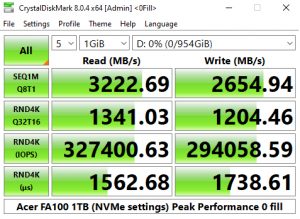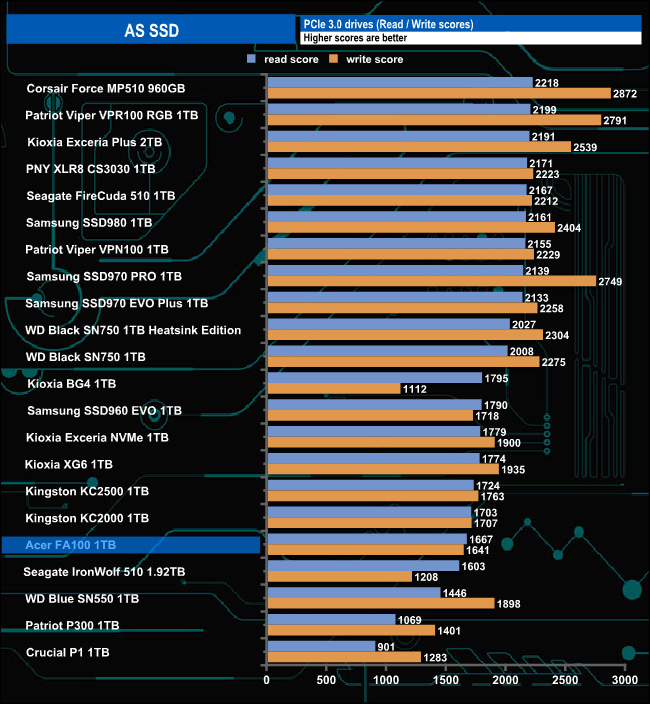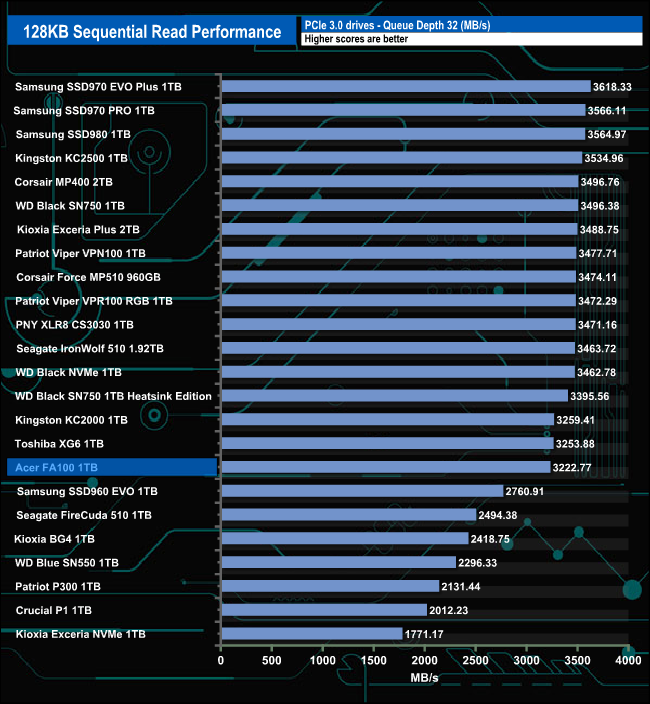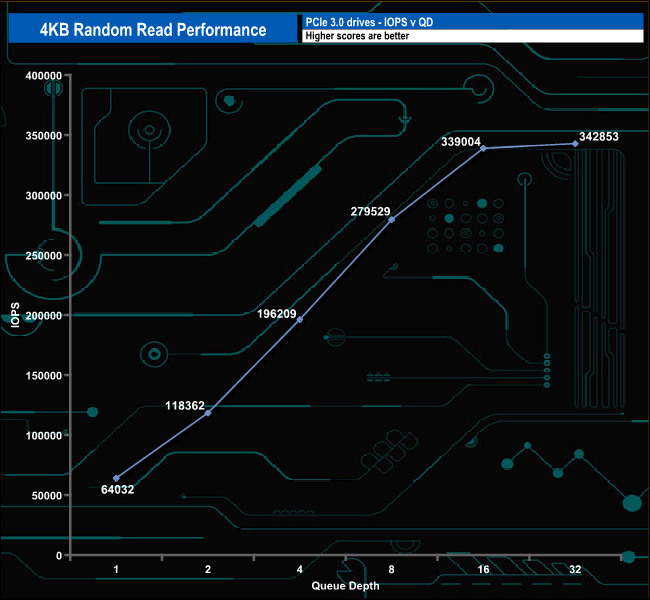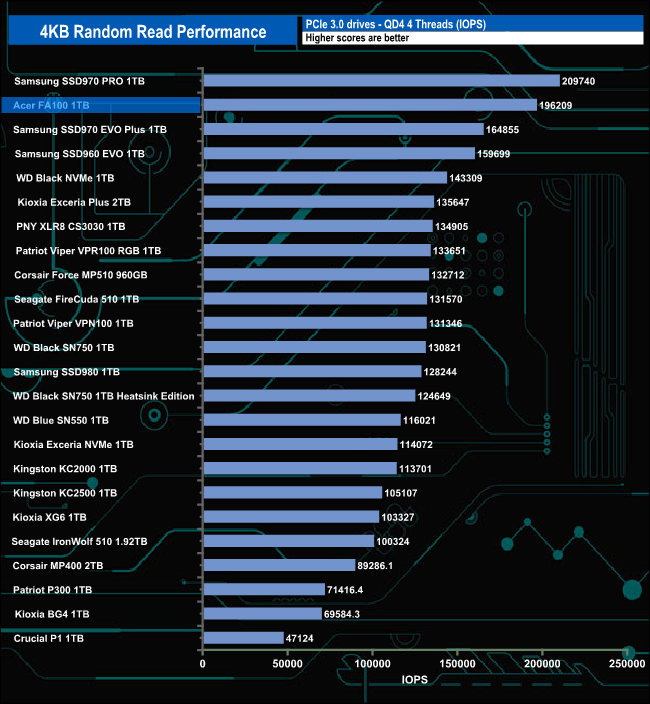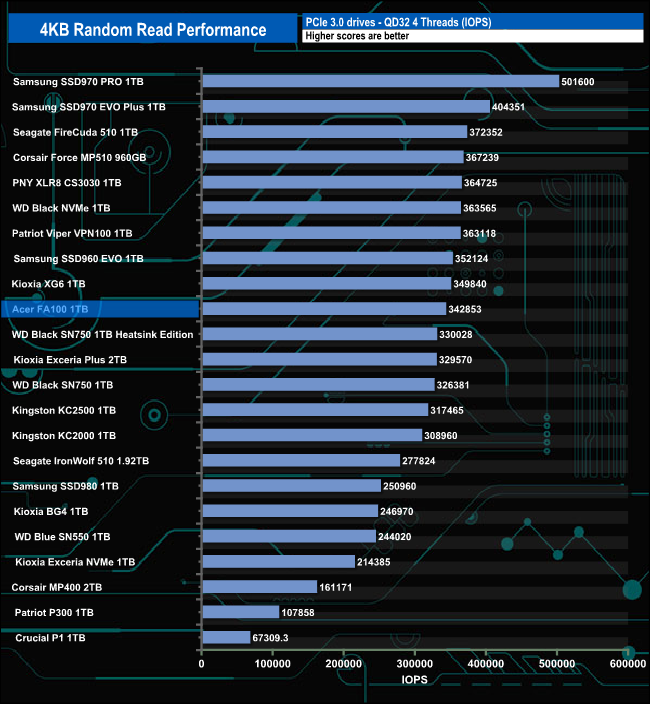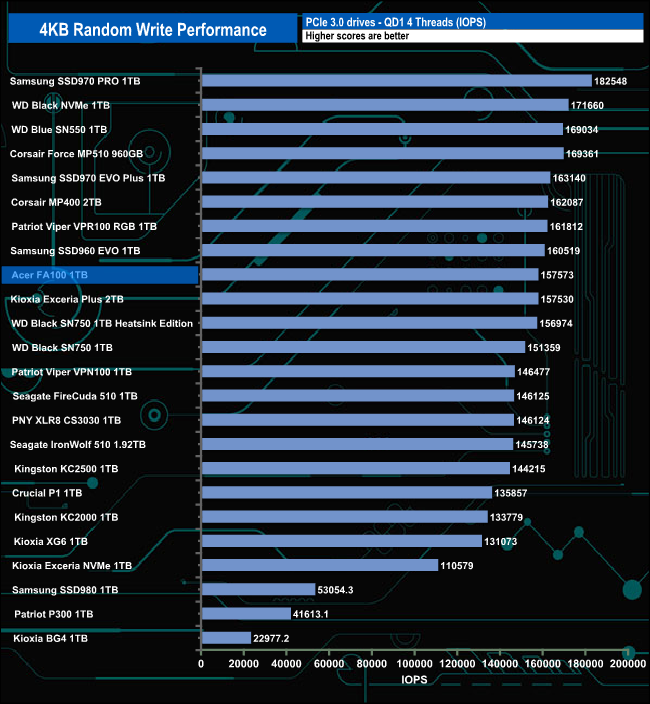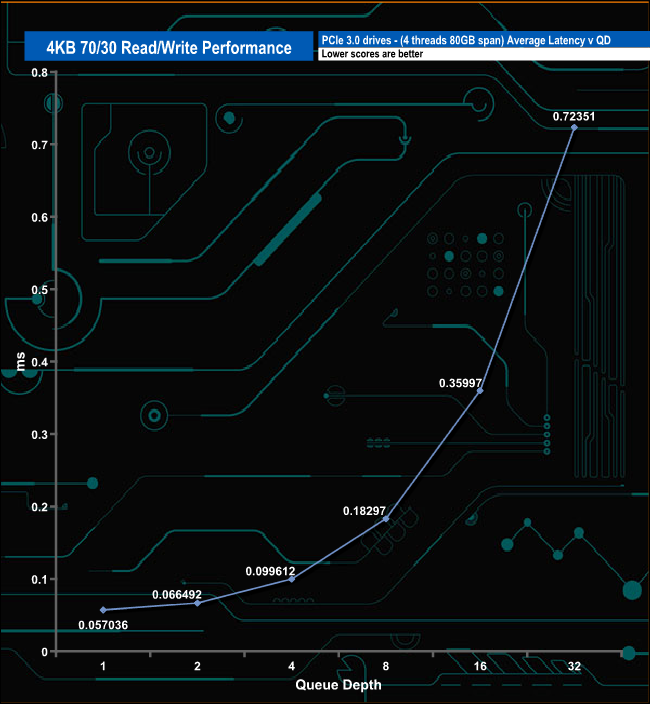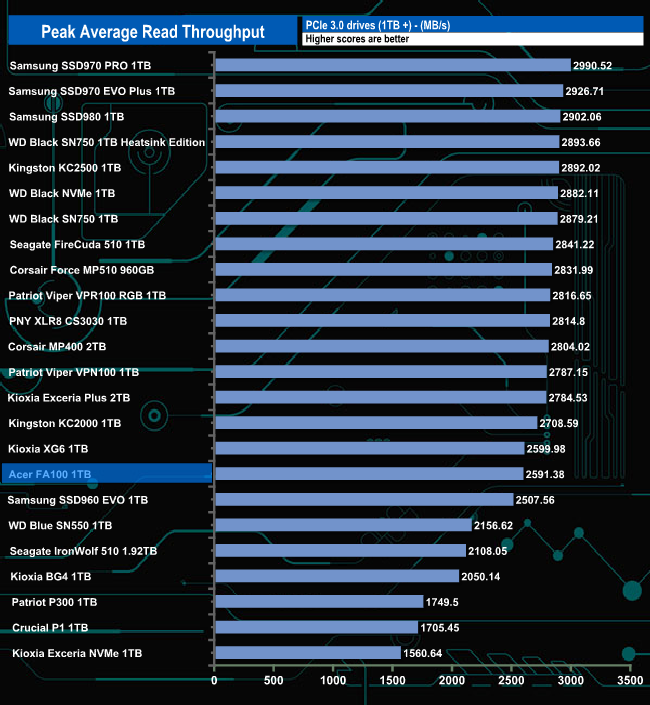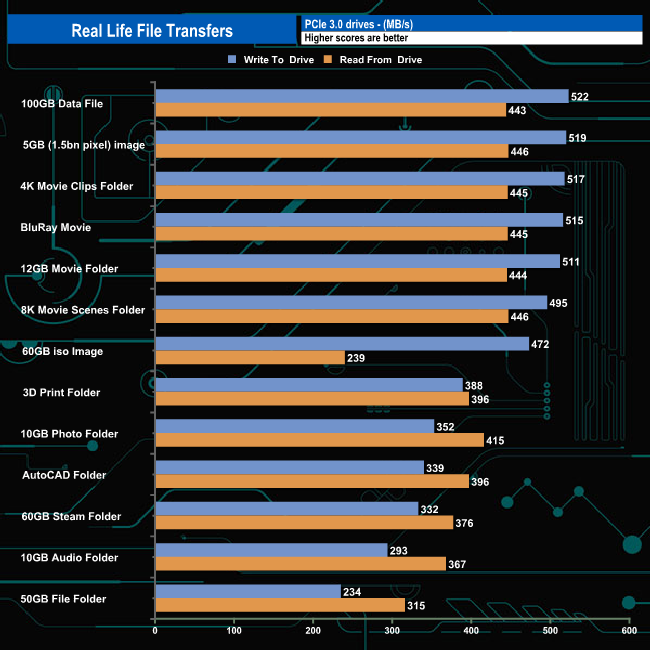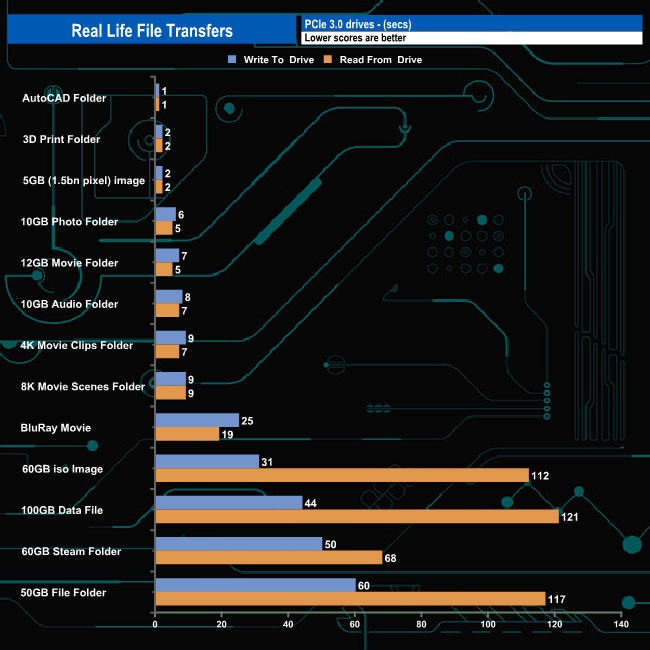
Released at the same time as the SA100 2.5in SATA drive we recently reviewed, the FA100 is the first Acer-branded NVMe M.2 drive. The PCIe Gen3 x4 FA100 uses a combination of 3D TLC NAND and a 4-channel controller. Is it worth the £89.99 asking price?
The Acer FA100 product line comprises five capacities; 128GB, 256GB, 512GB, 1TB (the drive we are reviewing here) and a flagship 2TB model. The drives use an Innogrit Shasta+ (IG5216) 4-channel controller and 3D TLC NAND.
The 1TB drive has the fastest Sequential read/write ratings of the line-up, at up to 3,300MB/s and 2,700MB/s respectively. The 128GB drive is rated as up to 950MB/s reads and 650MB/s writes, the 256GB drive 1,950MB/s (reads) 1,300MB/s (writes), 512GB 3,200MB/s (reads) 2,200MB/s (writes) and the 2TB model, 3,150MB/s reads and 2,600MB/s writes.
4K Random performance for the 1TB drive is quoted as up to 325,000 IOPS for reads and up to 293,000 IOPS for writes. Random performance for the rest of the range is stated as up to 51,000 IOPS reads and 161,000 writes for the 128GB model, 100,000 IOPS and 273,000 IOPS (read/write respectively) for the 256GB drive, 190,000 and 296,000 (read/write respectively) for the 512GB drive and 379,000 IOPS reads and 280,000 IOPS writes for the 2TB drive.
Power consumption for the 1TB model is listed as 1.70W active read, 3.86W active write and 1.03W idle. Acer quotes a TBW endurance figure for the drive of 600TB and it's backed by a 5-year warranty.
Physical Specifications:
- Usable Capacities: 1TB.
- NAND Components: 3D TLC NAND.
- NAND Controller: Innogrit Shasta+ IG5216BBA (4-channel).
- Cache: DRAMless design, uses Host Memory Buffer (HMB) technology.
- Interface: PCIe Gen3 x4, NVMe 1.4.
- Form Factor: M.2 2280.
- Dimensions: 22 x 80 x 2.3mm
- Drive Weight: 6.35g
Firmware Version: 1.Z.J.2X
The FA100 drive comes in a compact box with an image of the drive on the front below which is a sticker carrying the drive's capacity. To the right of the sticker are four icons representing high performance, the fact that the drive comes with a 5-year warranty, that it's power-saving and it comes with free cloning software (by downloading Acronis True Image OEM from the Acer website). The rear of the box has a small list of the drive specifications.
The 1TB Acer FA100 is a single-sided design with all the components built on one side of the M.2 2280 PCB. To help dissipate the heat generated by the drive, the label on the back of the drive has a layer of copper under it.
Under the product label on the front of the drive sit four 256GB BIWIN branded NAND packages and the Innogrit Shasta+ controller. The Innogrit Shasta+ (IG5216BBA) is a DRAMless design built on a 28nm process supporting up to 2TB of SLC, MLC, TLC and QLC NAND with ONFI 4.1 and Toggle 4.0 using four NAND channels. As it's a DRAMless design it makes use of Host Memory Buffer (HMB) technology for mapping tables.
For testing, the drives are all wiped and reset to factory settings by HDDerase V4. We try to use free or easily available programs and some real-world testing so you can compare our findings against your own system.
This is a good way to measure potential upgrade benefits.
Main system:
AMD Ryzen 5 3600X, 16GB DDR4-2400, Sapphire R9 390 Nitro and an MSI MPG X570 Gaming Edge Wifi motherboard
Other drives
Corsair MP400 2TB
Corsair Force MP510 960GB
Crucial P1 1TB
Kingston KC2000 1TB
Kingston KC2500 1TB
Patriot Viper VPR100 RGB 1TB
Patriot Viper VPN100 1TB
PNY CS3030 1TB
Seagate FireCuda 510 1TB
Samsung SSD970 PRO 1TB
Samsung SSD960 EVO 1TB
Samsung SSD960 EVO Plus 1TB
Kioxia Exceria Plus 2TB
Kioxia Exceria NVMe 1TB
Kioxia BG4 1TB
Kioxia XG6 1TB
Western Digital Black SN750 1TB
Western Digital Black SN750 1TB with Heatsink
Western Digital Blue SN550 1TB
Software:
Atto Disk Benchmark 4.
CrystalMark 6.0 & 8.0.0.
AS SSD 2.0.
Futuremark PC Mark 10.
All our results were achieved by running each test five times with every configuration this ensures that any glitches are removed from the results. Trim is confirmed as running by typing fsutil behavior query disabledeletenotify into the command line. A response of disabledeletenotify =0 confirms TRIM is active.
CrystalDiskMark is a useful benchmark to measure theoretical performance levels of hard drives and SSD’s. We are using v6.0 and v8.0
The Acer FA100 handles the CrystalDiskMark QD32 T1 test pretty well, its 551.8MB/s read score backed by a 480.6MB/s write result sees it just slip into the top 10 Gen3 drives we've tested.
The official Sequential read/write performance figures for the FA100 are up to 3,300MB/s and 2,700MB/s for reads and writes respectively. As you can see from the benchmark result screens we couldn't quite get to those maximums.
CrystalDiskMark 8
CrystalDiskMark 8 Peak Performance Profile.
CrystalDiskMark 8 Real World Profile.


Using the more advanced CrystalDiskMark 8 in its default setting as well as the Peak Performance and Real World profiles saw the Sequential test results fall just shy of the official maximum figures of 3,300MB/s for reads and 2,700MB/s for writes. The best read result we saw was 3,224MB/s while 2,654MB/s was the best write result.
However with the 4K random results from testing the drive using the Peak Performance profile we could confirm the official 4K figures of up to 325,000 IOPS for reads and up to 293,000 IOPS for writes. The best test figures we got were 327,400.63 IOPS for reads and 294,274.90 IOPS for writes.
The ATTO Disk Benchmark performance measurement tool is compatible with Microsoft Windows. Measure your storage systems performance with various transfer sizes and test lengths for reads and writes. Several options are available to customize your performance measurement including queue depth, overlapped I/O and even a comparison mode with the option to run continuously. Use ATTO Disk Benchmark to test any manufacturers RAID controllers, storage controllers, host adapters, hard drives and SSD drives and notice that ATTO products will consistently provide the highest level of performance to your storage.
We are using version 4.0 for our NVMe disk tests.
Using the ATTO benchmark we couldn't quite get to the official maximum figures for either reads, 3,300MB/s or writes, 2,700MB/s. The best we saw from the benchmark was 3,000MB/s and 2,470MB/s for reads and writes respectively.
AS SSD is a great free tool designed just for benching Solid State Drives. It performs an array of sequential read and write tests, as well as random read and write tests with sequential access times over a portion of the drive. AS SSD includes a sub suite of benchmarks with various file pattern algorithms but this is difficult in trying to judge accurate performance figures.
The FA100 struggled in the more demanding AS SSD benchmark. With a read score of 1667 and 1641 for writes it sits in the bottom half of the results chart.
128KB Sequential Read / Write.
The setup for the tests is listed below.
Transfer Request Size: 128KB, Thread(s): 1, Outstanding I/O: 1-32.
In our own Sequential performance testing, we fell just short of the 3,300MB/s read and 2,700MB/s official maximum speeds for the drive. The peak write figure of 2,654MB/s (QD16) was closer to the official figure than the 3,222MB/s (QD32) read result.
128KB Sequential Read v QD compared.
At QD1 the drive sits at the bottom of the Sequential read results chart, but as the tested queue depths deepen the drive's performance improves in relation to the drives around it in the chart.
128KB Sequential Write v QD compared.
Whereas the read performance of the FA100 improves in relation to the drives around it as the tested queue depth deepens, when it comes to Sequential writes the opposite is true. At QD1 the drive sits in the top10 of drives tested but by QD32 it's in the bottom half of the results chart.
4K Sustained Random Read.
The setup for the tests is listed below.
Transfer Request Size: 4KB, Outstanding I/O: 1-32.
Officially the 1TB Acer FA100 is rated at up to 325,000 IOPS for reads. With our 4-treaded testing, we could confirm that maximum figure and indeed improve on it, with a score of 342,853 IOPS (QD32).
4K Sustained Random Read v QD compared.
At QDs 1&2, the 1TB FA100 is the fastest consumer Gen3 drive we've seen to date. At QD4 the drive drops to second place and the fall continues as the queue depths deepen until the end of the test at QD32 where the drive sits in tenth place in the results chart.
4K Sustained Random Write.
The setup for the tests is listed below.
Transfer Request Size: 4KB, Outstanding I/O: 1-32.
Unlike the 4K random read results, when it came to random writes we couldn't quite hit the official maximum of 293,000 IOPS but with a peak result of 285,455 (QD32), we weren't that far off.
4K Sustained Random Write v QD compared.
At the lower tested queue depths (1-4) the drive hovers in the top 10 of our results chart but at QD32 the drive sits very near to the bottom of the chart.
4K 70/30 Mixed Read/Write Performance.
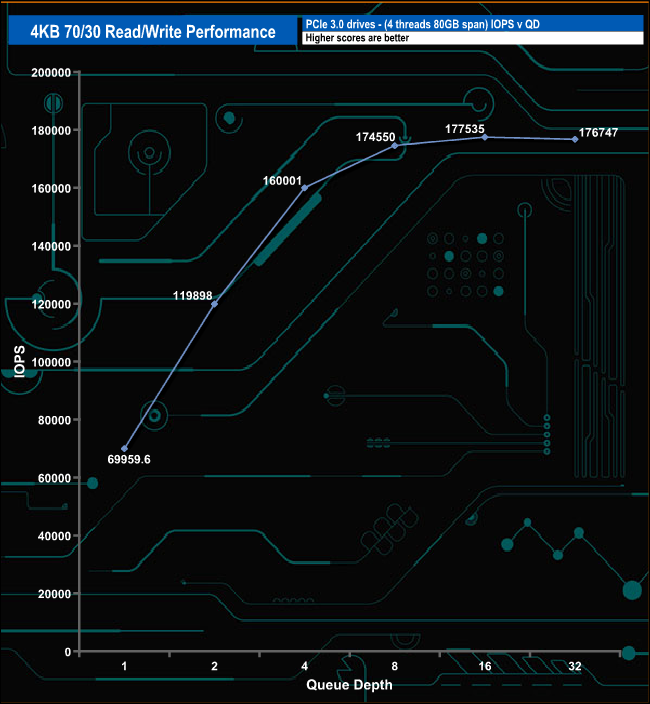
The 1TB Acer FA100 handles the 4K 70/30 read/write mixed test pretty well. The drives performance peaks at QD16 at 177,535 IOPS (727.18MB/s) before dropping back to finish the test run (QD32) at 176,747 IOPS (724.70MB/s).
In our read throughput test, the drive peaks at the end of the test (16MB block) with a figure of 2,591.38MB/s which sees the drive in the bottom half of our results chart.
In our write throughput test, the drive peaks at the 2MB block mark with a figure of 2,668.19MB/s before eventually finishing the test run at 2,523.19MB/s (16MB block).
The PCMark 10 Full System Drive Benchmark uses a wide-ranging set of real-world traces from popular applications and common tasks to fully test the performance of the fastest modern drives. The benchmark is designed to measure the performance of fast system drives using the SATA bus at the low end and devices connected via PCI Express at the high end.
The goal of the benchmark is to show meaningful real-world performance differences between fast storage technologies such as SATA, NVMe, and Intel’s Optane. The Full System Drive Benchmark uses 23 traces, running 3 passes with each trace. It typically takes an hour to run.
Traces used:
Booting Windows 10.
Adobe Acrobat – starting the application until usable.
Adobe Illustrator – starting the application until usable Adobe Premiere Pro – starting the application until usable.
Adobe Photoshop – starting the application until usable.
Battlefield V – starting the game until the main menu.
Call of Duty Black Ops 4 – starting the game until the main menu.
Overwatch – starting the game until main menu.
Using Adobe After Effects.
Using Microsoft Excel.
Using Adobe Illustrator.
Using Adobe InDesign.
Using Microsoft PowerPoint.
Using Adobe Photoshop (heavy use).
Using Adobe Photoshop (light use).
cp1 Copying 4 ISO image files, 20 GB in total, from a secondary drive to the target drive (write test).
cp2 Making a copy of the ISO files (read-write test).
cp3 Copying the ISO to a secondary drive (read test).
cps1Copying 339 JPEG files, 2.37 GB in total, to the target drive (write test).
cps2 Making a copy of the JPEG files (read-write test).
cps3 Copying the JPEG files to another drive (read test).
The best performance in the creative group of tests was the 546MB/s from the Adobe Photoshop heavy use test trace, while the 303MB/s for the Adobe After Effects trace was pretty good as well. The Acer FA100 also performed well in the file transfer tests.
Overall the 1TB Acer FA100 seems to struggle a wee bit with the PCMark 10 Full System Drive Benchmark with a bandwidth result of 239.52MB/s, which puts it in the bottom half of the results chart.
For the long term performance stability test, we set the drive up to run a 20-minute 4K random test with a 30% write, 70% read split, at a Queue Depth of 256 over the entire disk. The 1TB version of the Acer FA100 averaged 21,892 IOPS for the test with a very good performance stability of 83%.
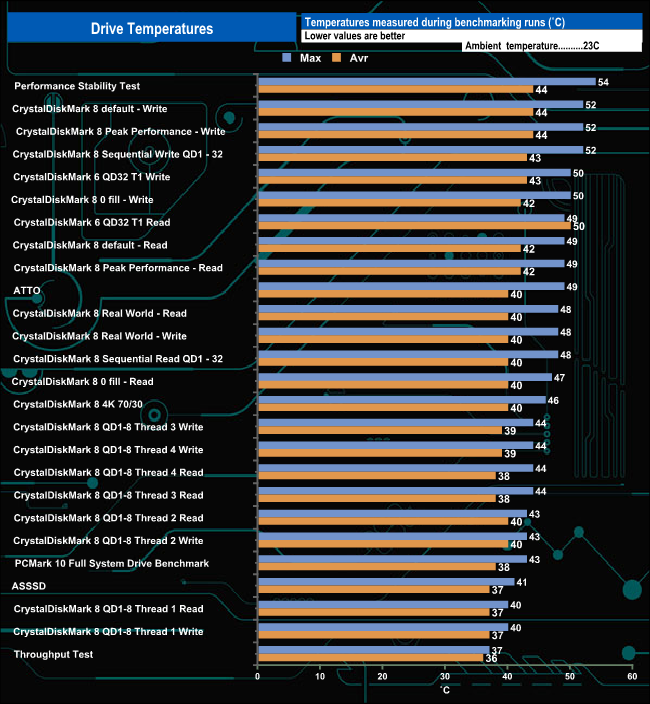
We took note of the drive’s temperature during some of our benchmarking runs. The label on the rear of the drive has a layer of copper under it to help with dissipating the heat the drive generates. The hottest the drive got was 54° C (with a 23° C ambient temperature) during the Performance Stability test, a test that really does push the drive hard.
To test the real-life performance of a drive we use a mix of folder/file types and by using the FastCopy utility (which gives a time as well as MB/s result) we record the performance of drive reading from & writing to a 256GB Samsung SSD850 PRO.
We use the following folder/file types:
- 100GB data file.
- 60GB iso image.
- 60GB Steam folder – 29,521 files.
- 50GB File folder – 28,523 files.
- 12GB Movie folder – (15 files – 8 @ .MKV, 4 @ .MOV, 3 @ MP4).
- 10GB Photo folder – (304 files – 171 @ .RAW, 105 @ JPG, 21 @ .CR2, 5 @ .DNG).
- 10GB Audio folder – (1,483 files – 1479 @ MP3, 4 @ .FLAC files).
- 5GB (1.5bn pixel) photo.
- BluRay Movie – 42GB.
- 21GB 8K Movie demos – (11 demos)
- 16GB 4K Raw Movie Clips – (9 MP4V files).
- 4.25GB 3D Printer File Folder – (166 files – 105 @ .STL, 38 @ .FBX, 11 @ .blend, 5 @ .lwo, 4 @ .OBJ, 3@ .3ds).
- 1.5GB AutoCAD File Folder (80 files – 60 @ .DWG and 20 @.DXF).
The Acer FA100 handled our real-life file tests without any real problems although it has to be said that it seemed to find reading the 60GB iso image a bit of a struggle judging from the read score and the time it took to carry out the task.
To get a measure of how much faster PCIe NVMe drives are than standard SATA SSD's we use the same files but transfer to and from a 2TB Kioxia Exceria Plus drive:
Switching over to all NVMe storage testing saw some impressive jumps in performance. Three of the write transfers and six of the read were over 2GB/s. Once again the read performance when the drive was working on the 60GB iso image was slower than we expected and on this occasion, it was joined by the read performance when dealing with the 100GB data file.
The FA100 product line (at the time of writing) is the only range of SSDs using a PCIe interface in Acer's new storage portfolio, which was created in partnership with Chinese chip manufacturer BIWIN. At launch the FA100 family is made up of five capacities; 128GB, 256GB, 512GB, 1TB (the drive we are reviewing here) topped off with a 2TB flagship model.
The FA100 uses an Innogrit Shasta+ (IG5216BBA), four-channel controller. The Shasta+ is a dual-core DRAM-less design that should help keep costs down. Without a dedicated DRAM cache, it uses Host Memory Buffer (HMB) technology for table mapping duties and for the FA100 the controller has been teamed up with 3D TLC NAND.
When it comes to Sequential performance, the 1TB FA100 is the fastest drive in the range with an official rating of up to 3,300MB/s for reads and up to 2,700MB/s for writes. We couldn't quite hit those maximum figures with our testing but got mighty close. The fastest Sequential read figure we saw was in CrystalDiskMark 8 at 3224.27MB/s while the fastest write score of 2646.75MB/s also came in the CrystalDiskMark benchmark.
The drive gets 4K random ratings of up to 325,000 IOPS and up to 293,000 IOPS for read and writes respectively. This time the 1TB drive isn't the fastest in the line-up. The flagship 2TB drive has the highest read rating at 379,000 IOPS while the 512GB model at 296,000 IOPS has the fastest random write performance.
We could confirm the official random figures of the 1TB drive with the CrystalDiskMark benchmark with the tested drive producing a read figure of 327,400.63 IOPS with writes at 294,274.90 IOPS. In fact in our own 4K random read tests it produced the best results we've seen to date for a Gen3 drive at QDs 1 and 2.
The 1TB FA100 has a decent TBW endurance rating of 600TB. The rest of the range has ratings of; 70TB for the 128GB drive, 150TB for the 256GB and 300TB for the 512GB drives while the flagship 2TB model has a 1,200TB rating and Acer backs the range with a 5-year warranty.
Acer informed us that the UK MSRP for the 1TB version of the FA100 is £89.99 and availability is expected at Scan shortly.
Discuss on our Facebook page HERE.
Pros
- Overall performance.
- Endurance.
- Five-year warranty.
Cons
- DRAM-less cache.
KitGuru says: Acer has entered a highly competitive market sector with the FA100. It's a fast drive with decent endurance but it will need a little shaved off the MSRP to help it fight its corner.
 KitGuru KitGuru.net – Tech News | Hardware News | Hardware Reviews | IOS | Mobile | Gaming | Graphics Cards
KitGuru KitGuru.net – Tech News | Hardware News | Hardware Reviews | IOS | Mobile | Gaming | Graphics Cards











